|
FAQs about Flatworm Identification
3
Related Articles: Flatworms
(incl. Planaria), Pest
Flatworm Control by Anthony Calfo, Worms, Featherduster
Worms,
Related FAQs: Flatworm
Identification, Flatworm ID 2,
Flatworm ID 4, Flatworm ID 5, Flatworm ID 6, & FAQs on: Flatworms/Planaria 1, Flatworms 2, Flatworms 3, Flatworm Behavior, Flatworm Compatibility, Flatworm Control, Predator Control, Chemical Control, Flatworm Selection, Flatworm Systems, Flatworm Feeding, Flatworm Disease, Flatworm Reproduction, & Worms, FAQs: Worm Diversity FAQs, FAQs 2,
FAQs 3, & Worm IDs
1, Worm IDs
2, Worm IDs 3, Worm IDs 4,
Worm IDs 5, Worm IDs 6, Worm
IDs 7, Worm IDs 8, & Worm ID
FAQs by Group/Phylum: Flatworm
Identification ID, Nemertean,
Proboscis, Ribbon Worm ID, Nematode, Roundworm ID,
Nematomorpha,
Horsehair Worm ID, Acanthocephalans,
Thorny-headed Worm ID, Polychaete Identification, Polychaete ID 2, Tubeworm ID, Hirudineans, Leech ID, Echiuran Worm ID, Invertebrate
Identification,
|
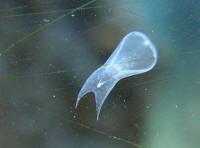
|
|
Euphyllia Eating Flatworm? Polyclad --
4/30/09
Hi!
<Hi there, Cath!>
I've lost several of my Euphyllia corals in the last couple
of months.
<Uh-oh>
This morning, I've found what I think is a kind of flatworm
on many of my frog, torch and ancora pieces. With a close look
and more attention, I saw that all my Euphyllia are literally
infested by this 'little' (some are up to
½') beast.
<Yikes!>
There are also a lot of yellow eggs around them. Here is, in a
joined piece, a picture of the beast. The shot was not taken by
me, but by a fellow reefer of my area who has the same problem.
What exactly is this flatworm?
<Looks like a Polyclad of some sort to me (see link below for
more info).>
Is there a way to get rid of them?
<Manual/diligent removal of all visible worms/eggs. In
addition, check any and all other corals (and rockwork if
possible) for further evidence and remove any you come across.
I'd also put the corals, one at a time, in small tub or
container with tank water, and using something like a turkey
baster, blast any areas of dead skeleton/rockwork with water to
hopefully dislodge any unseen juveniles.>
I've made a lot of searches and haven't found anything
about it.
<That's understandable. I looked everywhere and only found
a couple of unconfirmed hobbyist reports related to Euphyllids
and suspected Polyclad predation. Furthermore, I was unable to
find any documentation, anywhere, confirming actual predation of
any coral species by these worms at all. That's not to say
that it's not possible however. Apparently, there's a lot
of information still needing to be discovered/revealed regarding
these large worms. The general consensus is that they're all
predatory - consuming various colonial or sessile organisms such
as Tunicates, Bryozoans, bivalves, barnacles, etc, as well as
other small invertebrates such as amphipods, small snails,
Polychaete worms, and even other flatworms. Also, some evidently
feed on algae, especially diatoms, but only as juveniles. The
problem with this situation is that unless you've actually
seen the worms eating live coral tissue, you have to consider
that their presence may be secondary/incidental. Perhaps the
corals are dying due to one or several other reasons -- for
instance environmental issues (water chemistry, chemical
warfare/allelopathy, etc), or due to fish/crabs, etc picking at
them. The culprit could even be another type of flatworm (perhaps
Acoels?) or something else entirely. The Polyclad flatworms could
be there to prey on the real predator(s), or other
incidental/harmless amphipods, etc, that have congregated to
feast on the sudden bloom of algae and/or dying coral tissue.
Admittedly, an infestation level of anything near a damaged coral
doesn't look good, but I'd rule out other possibilities
just to be sure. I have to admit, if I were in your shoes,
I'd likely err on the side of caution and remove as many
Polyclads as I could. Had there been just one or two, I'd
have left it/them, but in the case of many -- bye bye!
I've got some links for you to read through. Here's a
similar situation: FAQ titled 'Euphyllia Health issues /
hitch hiker ID... likely allelopathy, env. 6/9/08', at this
link: http://www.wetwebmedia.com/carydisf7.htm
Allelopathy issues: http://wetwebmedia.com/cnidcomppt3.htm
Flatworms: http://www.wetwebmedia.com/flatworms.htm >
Thank you!
Cath
<You're very welcome! Take care, LynnZ>
|
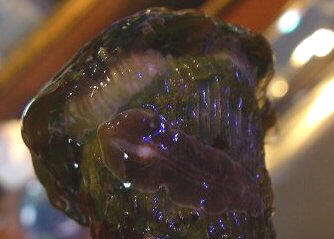 |
|
Halimeda seeds? 4-13-09
Crew,
<Ryan>
I am a long time reader and I truly appreciate the site. I have
two identifications questions for you. The first is a golf ball
sized seed pod looking thing that came attached to a clump of
Halimeda, I have searched
plenty but found nothing about Halimeda seeds or anything of the
seed ball.
<Mmm, no... Halimeda is a Thallophyte (an algae)... reproduce
by spores... true plants (Embryophytes) have seeds>
I have now noticed little green maybe Nudibranchs on the tanks
glass near the seed ball. I just want to check the IDs to be sure
I am not unleashing a plague in my tank. I know I should of
probably not put something in my tank with out knowing what it
exactly what it is but the store didn't think it was a big
deal.
Thanks for the help,
Ryan King
Current Tank setup:
AGE - three months
55 Gallon with 17 lbs live rock and 60 lbs lace.
Lighting is a 65x4 power compact.
30 Gallon sump with about 20 gallons of water in it.
The tank runs at 78F and salinity of 1.024
I used instant ocean salt mix and RO/DI water.
Current stock:
Fish: Yellow Tang and two Ocellaris Clowns
Shrimp: Cleaner, pair of Peppermint
Stars: Blue Star, Brittle Star
Snails: 20 various small cleaners
Crabs: 10 Red Leg hermits, 10 Blue Leg hermits
Coral: Xenia, GSP, Mushroom, and a few misc frags
<Looks to me to be a colonial Ascidian... the clear bunch is
dead... Bob Fenner>
|
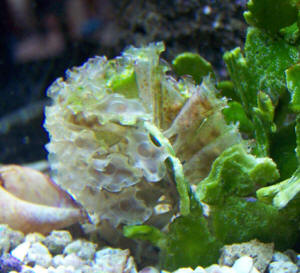 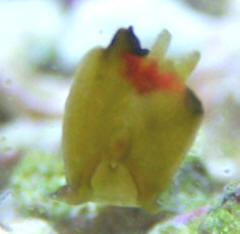 |
|
Correction to today's dailies -
4/13/09
Hiya Bob!
<Mich>
So I was looking at that ID question that came and talked to Lynn
about it this morning. It is definitely not a colonial
Ascidian.
Lynn found these photos:
http://www.jaxshells.org/vilano60.htm
http://www.biol.andrews.edu/EVERGLADES/organisms/invertebrates/mollusks/true
_tulip_snail/egg_cases_of_tulips.jpg
We think it is a snail egg mass, likely that of a tulip snail,
which likely wouldn't be good news for Ryan's tank to
have such carnivorous snails.
http://www.indyzoo.com/pdf/TrueTulipSnail.pdf
<Ohhh!>
And the other image which he thought were Nudibranchs look to be
Acoel flatworms, specifically Convolutriloba, similar to the
photo here:
http://macropyga.googlepages.com/convolutriloba_1.jpg
Which came from this site:
http://macropyga.googlepages.com/
and the differences can be seen here:
http://macropyga.googlepages.com/identification
Lynn found all these images. She's really great at getting
these ID's!
Cheers,
Mich
<Thanks much... Will amend on the morrow... a shame that
I've deleted the original senders email address. BobF>
He wrote back!!!! YAY!!!!! Lynn replied to him. M
<Ahh, very good. B
Re: Halimeda seeds? Egg Capsules and Acoel Flatworms -
4/13/09
Bob,
<Hi Ryan, Lynn here this evening. I sure am glad you wrote
back. My fellow crew member, Mich, and I put our heads together
this morning and came up with some information regarding the two
mystery items in your tank. The follow-up will be posted tomorrow
at the dailies, but I've included a copy here as well (see
below). The only thing I'd like to add is that we've got
lots of information at WWM regarding Convolutriloba flatworms and
Tulip snails in marine systems. Just enter the terms in our
search engine and you should be good to go:
http://www.wetwebmedia.com/WWMAdminSubWebIndex/question_page.htm
.>
Thanks for the info - I guess it shows that I am clearly an
electrical engineer and not a biologist (algae has no seeds...
doh).
<Heeheeee! No worries. I hate to think of the wholesale
Godzilla destruction I could cause if I even stepped a toe into
the world of electrical engineering!>
I do enjoy the site and your book.
<On behalf of Bob and the rest of the crew, I thank
you!>
Best Regards,
Ryan King
<Take care, LynnZ>
|
|
Little rust red things, Planaria, 4/6/09
I have these little rust red colored flat worm looking things on
my glass and now on my live rock.
Any idea what they are and how to get rid of them?
<Most likely Red Planaria, see here
http://www.wetwebmedia.com/pestflatwrmanthony.htm and related
FAQs for more.>
They are about 1/8" wide and slightly longer than wide
Please see attached picture.
<Tough to tell for sure from that picture.>
Thanks
Glenn
<Welcome>
<Chris>
|
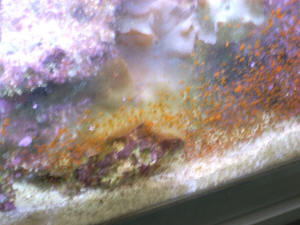 |
Mysterious Creature: Likely Flatworm 11/17/08
Hello Crew, <Hello Susan, Lynn here today.> I have had a 180
gallon reef type aquarium for about three years now. <Very nice.>
One of my favorite activities is to explore the marine-scape at night
with a flashlight and magnifying glass. <You're mind kind of
people!> It's amazing what turns up sometimes, <Yes,
indeed.> which brings me to my question. Last night I found a new
mysterious creature and my searches of WWM and Google have turned up
nothing as to its identity. So maybe you might have an idea what it
was. Unfortunately I don't have a photo, but I'll do my best to
describe it. <Okay> The creature was affixed to the glass at the
back, just above some rocks. It was somewhat circular in shape and flat
-- it looked a lot like a large amoeba, about 3" in diameter. It
was light brown in color and opaque. There was no discernible head,
although there was a white spot, like a large grain of sand, that
remained stationary relative to the movement of the animal. The
creature moved with a slow, circular motion, its shape changing fluidly
as it moved. Lightly frilled edges and occasional bubbled-up patches
formed underneath as it moved. <It might be some kind of flatworm,
but I'd need a photo to confirm.> I was so curious that I turned
on the fluorescent lights. It reacted to the light and got somewhat
smaller, moving slowly into a more elongated shape (about 1" x
2"). A darker area seemed to appear down the midline as it slowly
shimmied down the glass. It continued to grow smaller and more
elongated so that it was almost a sausage shape by the time it reached
the sand. Then it disappeared behind the rocks. <Terrific
observations. Yep, it sounds like a Polyclad flatworm, of which there
are many, many species. They're able to change shape just as you
described and are quite interesting to watch. I'd love to see a
photo of this little guy but I can sure understand why you weren't
able to get one. Hehee, they never seem to understand
�Stay right there while I grab my
camera!�. For more information on Polyclad flatworms,
please see the following link: http://www.wetwebmedia.com/flatworms.htm
> Anyway I am baffled and really curious about the identity of this
odd creature. Perhaps the Crew has seen something like this . . .
<Yes, we do get inquiries related to flatworms from time to time, as
can be seen in our FAQ�s starting here (be sure to go
through the associated links at the top of the page as well):
http://www.wetwebmedia.com/fltwmid.htm > Thanks for your help.
<You're very welcome. It's always a pleasure to converse
with a fellow enthusiast. Let's face it, there aren't that many
of us that sit up at night with a flashlight, peering into our tanks!
By the way, a flashlight with a red lens is terrific for observing
nocturnal animals and their behavior. The beam from a regular
flashlight is usually enough to send most critters diving for cover!
Also, if you have a magnifying glass, definitely get it out and take a
look-see. That opens up even more possibilities.> Susan P.S. I love
your web site. It's been a major source of information and advice
since I started this fabulous hobby and has kept me from making a lot
of mistakes. <Heehee! Me too! Bob has certainly amassed an
impressive amount of material that continues to grow with each incoming
query. Thank you sharing your observations with us! Take care,
Lynn>
|
Worm or what? 10/1/08 This thing
is huge (silver dollar size), and I think it's moving
relatively fast. It looks to me like a giant flat worm. <To me
as well. Perhaps a Pseudoceros sp.> I guess it can't
reproduce and I guess it might be the reason I have not had luck
with shrimp in this tank and my serpent stars are being eaten
slowly. <Mmm, doubtful it is this Platyhelminth...>
That's a whole lot of guessing so maybe I'll just attach
a picture and see what the experts think. Thanks, As always love
this site, Jesse <Read here:
http://wetwebmedia.com/flatworms.htm the linked files above. Bob
Fenner>
|
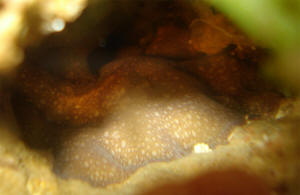 |
Planaria or other SW "bug"? ...Planaria
9/11/08 Hi WWD team, <WWD?> Hope all is well on your end
of this email. <Yes, thank you.> I have been through many of your
ID and FAQ pages and haven't found anything that seemed to fit my
scenario. I have a 75g future reef setup that has been up and running
for four months. I have around 50-60 lbs of base rock seeded with 20
lbs of live rock a SSB of around 2-3" aragonite that was dry (no
live sand here! Waste of money IMHO). <Will become live with
time.> No coral or fish yet since I wanted to give the tank a few
months to mature nicely. <Good idea.> I have a cleanup crew of
two emerald crabs, <Not to be trusted.> five Nassarius snails,
<Good.> five Trochus snails, <Good.> three Margarita snails
<These snails can live over a hundred years in their natural
environment which is significantly cooler than most reef systems. These
snails typically die a slow death from being cooked in the too warm
home aquarium.> and 10 blue leg hermits. <Again not to be
trusted.> Over the last two months, I have noticed some peculiar
white/off white "bugs" on the glass that some have considered
flatworms (I am assuming Planaria) but nothing definitive. <Yes,
they are Planaria.> They are small, maybe 1 mm at the most and crawl
around on the glass. I have also seen a few move more like an inchworm.
I do have plenty of amphipods I see scurrying around the live rock at
night and had seen small white bugs early on that were round with white
legs branching out all around (isopods or copepods?) <Could be
either.> that I think many people describe as the "tiny white
spiders on my glass" but this seem to be replaced with these
little buggers. I finally snapped a decent photo of them and was hoping
to see if you can ID. Here is a link to the suspects in question:
http://s400.photobucket.com/albums/pp87/bbl_nk/?action=view¤t=bugs
1.jpg <These are Planaria. More on them here:
http://www.wetwebmedia.com/flatworms.htm
http://www.wetwebmedia.com/pestflatwrmanthony.htm You can see similar
images here: http://www.wetwebmedia.com/flatwrmfaq2.htm > Thanks!
<Welcome!>
Brian
<Mich>
|
Flat worm? 03/24/2008 First thank you for
the service that you provide. <<Thanks for the comments.
Andrew here today>> I have searched the site for similar
flat worms as well as other sites and I cant really make up my
mind what to do about these guys. I have a CPR hang on refugium
with built in protein skimmer. I saw three of these guys when
looking at the fuge from the side today. I pulled one out with
tweezers to try to get a picture which I am not very good at
anyway. Sorry about the quality. They seem light brown when out
of the tank and slightly reddish when under the light. I have
only seen these in my fuge on my macro algae. I have not seen
them anywhere in the display. I have a six line wrasse perhaps he
/ she eats them? They are only a few millimeters in length and
have a uniform border, no jagged edges. <<Planaria
flatworms. They thrive better in lower flow areas of the tank,
which is probably why your noticing them in your fuge. If they
are not in plague proportions, then you can leave them alone, or
simply such them out when you see one with a turkey
baster>> The flow in the CPR is very low as there is only
the inlet pump (RIO) for circulation and protein skimming. I have
a ton of flow in the main tank as it is sps dominated hence my
concern. Any info would be greatly appreciated. Here is the best
I could do picture wise.
http://i250.photobucket.com/albums/gg252/mlgiii23/worm.jpg
<<Thanks for the questions and the nice photo, hope this
helps. A Nixon>>
|
|
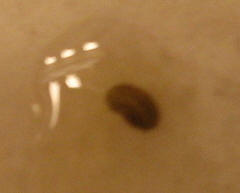
|
|
Strange Creature... Planaria... Mmmm, flatworms
3/9/08 Hey Gang. <Hi Wuf, Mich here.> I have been
trying to identify this creature for a few days. I can't for
the life of me figure out what it is. They are starting to
accumulate on some of my rocks. To give you an idea of scale, the
specimen pictured in IDme1.jpg is right at 1/16th of an inch. Any
idea? -wuf <Well the good news... Yes I can tell you what it
is... The bad news... you don't want it. Is a pest, an Acoel
flat worm. Yours is looking like its reaching plague proportions.
You will likely need to address the situation. More here:
http://www.wetwebmedia.com/flatworms.htm
http://www.wetwebmedia.com/pestflatwrmanthony.htm Sorry to be the
bearer of bad news, Mich>
Re: Strange Creature... Planaria... Mmmmm
Flatworms 3/10/08 I guess the good news is now I know what
the problem is, so now I can attack it. Figure a few taps of a
hammer to the bottom glass should take care of them all (j/k).
<Heehee! I feel your pain! Happy siphoning.> Thanks for
your time, Mich. <Happy to help! Sorry it wasn't better
news for you. Mich> -w
|
|
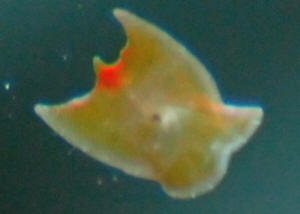 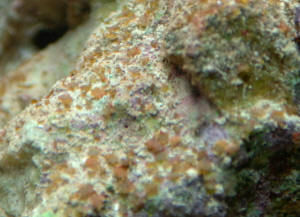
|
| Worm ID please 3/3/08 Hi!
<Cath> Here is a picture of ''the
thing''.(joined piece) A reefer of my area see it on is
hammerhead. I guess it's a kind of flatworm but I'm not
sure...if so, is it a bad one? Regards. Cath <Are some sort of
flatworm... Not likely harmful. Please read here:
http://wetwebmedia.com/flatworms.htm Bob Fenner> |
|
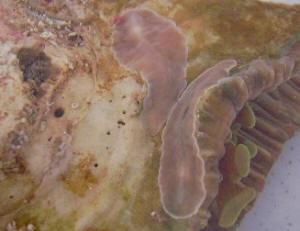
|
|
Some Kind of Flatworm... Planaria... Likely
Convolutriloba retrogemma 12/03/2007 Hi my name is Mike
<Hi Mike, my name is Michelle, my father shared your name.>
and have a 150 gal reef tank and have some kind of flat worm.
<Yup... > and I'm not sure if that's what they are.
<Is Planaria, a flatworm, likely Convolutriloba retrogemma>
I need to know what these little things are cause they are eating
all of my star polyps and some of my mushrooms. <They
generally flatworms tend to cause injury by smothering the
coral'¦ and once the corals begin to decay the flatworms
start to consume the Zooxanthellae. Your corals do not seem to be
covered to the point that I would expect death'¦ perhaps
there is something else at play here. More here and the related
links in blue: http://www.wetwebmedia.com/pestflatwrmanthony.htm
http://www.wetwebmedia.com/flatworms.htm
Good luck,
Mich>
|
|
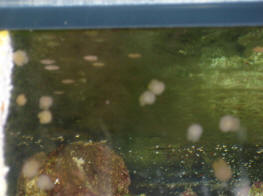
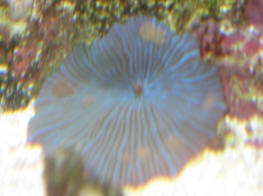
|
Flatworm ID -- 09/29/07 Hello crew, <Hi
there, Mich here> I'm a big fan of all of you. <Me too!
There are some fantastic people here!> My husband jokes around
with me that while most people emulate movie stars and baseball
players, my heroes are all scientists. <What's wrong with
that?> I've asked around some forums, but no one is quite
sure what to make of this. These grayish-blue colored flatworms are
very small, larger than a copepod, smaller than a
"normal" flatworm. It's been suggested that they are
blue due to something they've eaten. <Maybe, maybe not.>
They have the two horns at the end. <The end if you will.>
The "head" or front part is either segmented or has a
darker blue line behind it at the "neck." Some of the
larger ones *may* have little ruffles around the sides. I was
looking at them with a magnifying glass. I only see them on my red
slime algae, <They are likely elsewhere as well, just may be
harder to see in other places.> which I just had a bad outbreak
of. <No fun!> None of my corals are suffering, <A good
sign.> and I don't see any of these flatworms on any corals.
<Lucky!> Is it possible for flatworms to eat red slime? <I
guess anything is possible, they generally feed on detritus and
algae.> They seem to have shown up around the same time as the
red slime, <Maybe just the first time you noticed them because
of the background color of the Cyanobacteria.> and have exploded
in population the past few days. <Yikes!> The larger ones
have beautiful patterns on their backs, like a diamond back snake
or an x-ray, I can't tell on the small ones. It really seems
too good to be true--beautiful Cyano eating flatworms. <Yes I do
believe you are correct here.> By the way, my tank temperature
is 70* F maintained by chiller, <Really 70 F? Is this a typo or
are you really running a cool water system?> if that makes any
difference. <I know naught on cool water systems.> These are
the best out of about 50 pictures I took. <Oh yes, been there
done that!> I asked for a microscope for Christmas. <Heehee!
Will you ask Santa to deliver on to me as well?> Thank you for
any help you can give me. <Not too much I'm afraid. They do
look like flat worms and I would be very careful as they are known
to reach plague proportions. Though some aquarists report having a
continual population of Planaria that never gets out of control. If
it were my system I would try to remove as many as possible as
quickly as possible. Good luck to you,
Mich> |
|
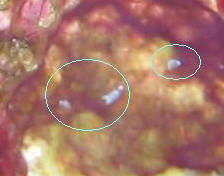
|
| Flatworms: Amphiscolops sp...what to do? -
8/19/07 I found these in my tank. Can you please guide me on
what to do, if anything at all? <No worries and no need for
action (nice picture, though!). These are harmless little flatworms
(Amphiscolops sp.). They tend to pop up in tanks and disappear a
short while later. Please see these links for more info re:
http://www.wetwebmedia.com/flatworms.htm
http://www.wetwebmedia.com/flatwrmfaq3.htm
<Take care --Lynn> |
|

|
|
|

